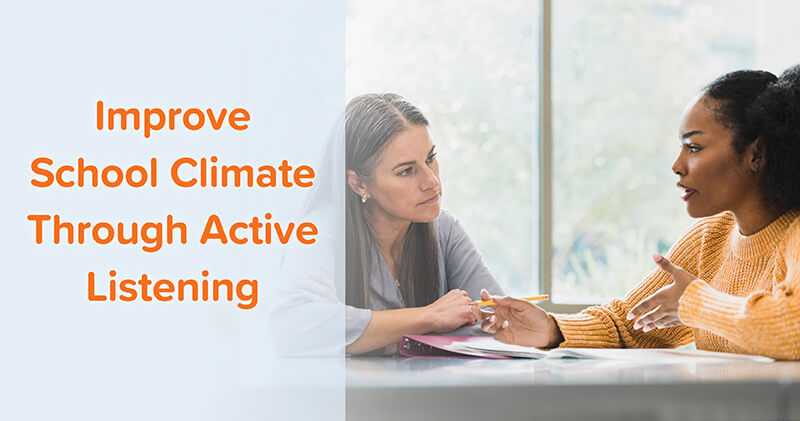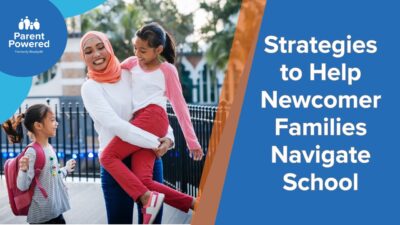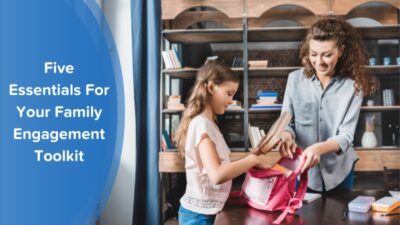by Maren Madalyn, contributing writer
It is no secret that this continues to be an especially tough season in the education community. Schools face lingering effects of the pandemic, impacting everything from student engagement to school safety to teacher well-being and much more. Educators navigate academic and social-emotional gaps as well as disruptive student behavior and lower student achievement. To add further stress, increased teacher absenteeism has also carried over, sure signs of teacher burnout.
What’s the common thread? As a collective, we are still processing the trauma caused by more than two years of uncertainty, loss, and grief. A responsive and inclusive approach to improving school climate is the antidote for healing our mental health.
Many schools already engage in practices on campus that contribute to a positive school climate. Student leadership councils and restorative practices are just a few of the many ways to cultivate a healthy school climate over time.

But crafting safe, supportive learning environments for students requires much more than the day-to-day occurrences of school life. The reality is that schools need their entire community engaged in school climate improvement, including families.
We at ParentPowered have published many resources about family engagement, including a roadmap for building connections with diverse families and expert tips for ongoing family communication. But across all approaches to family engagement in education, you’ll find that communication skills – specifically active listening skills – are the essential ingredient in a recipe for strong relationships between home and school.
With dedicated time and support, school leaders that build adults’ listening skills – teachers, parents, staff, and administrators – assemble a team prepared to create the best conditions for student learning and a positive school climate for everyone.

Active listening for improving school climate
Active listening cultivates healthy school relationships and a strong sense of community — both of which improve school climate, according to research. But what is active listening, and how does it contribute to safe, supportive learning environments?
What is active listening?
According to the University of Rochester, “active listening” is defined as “the ability to focus on a speaker, understand their message, comprehend the information and respond thoughtfully.” Both nonverbal and verbal cues are important for active listeners to demonstrate that they are fully engaged and connect with others.
| Verbal Cues | Non-Verbal Cues |
|---|---|
| Paraphrasing | Nodding |
| Open-ended questions | Smiling |
| Probing questions | Eye contact |
| Displayed empathy | Mirroring |
| Recalled information | Few distractions |
Why does it matter for school climate?
Active listening brings many benefits. The Center for Creative Leadership posits that active listening enables managers to better coach team members, improving overall team performance. It also helps teams navigate conflict resolution and empower employees in the workplace, resulting in better productivity.
More importantly, active listening is a core relationship skill necessary to cultivate trust between people and organizations. For schools, trust is the cornerstone of an effective family-school relationship and the first step towards building a positive school climate over time.
What does it look like in education?
Active listening comes in many flavors in the classroom environment. Learning Sciences International offers two simple but effective strategies for teachers to use with students that reinforce an active listening culture with classmates, which also supports their social and emotional learning. The UC Berkeley Graduate School of Education designed additional resources like this 15-minute active listening exercise for staff to improve their own collaboration, communication, and sense of community as a team. Some school leaders go even further. In one Louisiana school district established programs to uplift students’ voices on campus and encourage adult active listening in service of positive school climate.
Who’s missing here? Families!
Families are essential school climate factors, even though they are not always physically present on campus. Schools must include families in school climate improvement programs to positively impact student outcomes like graduation rates, student behavior, reading and math test scores, and more.
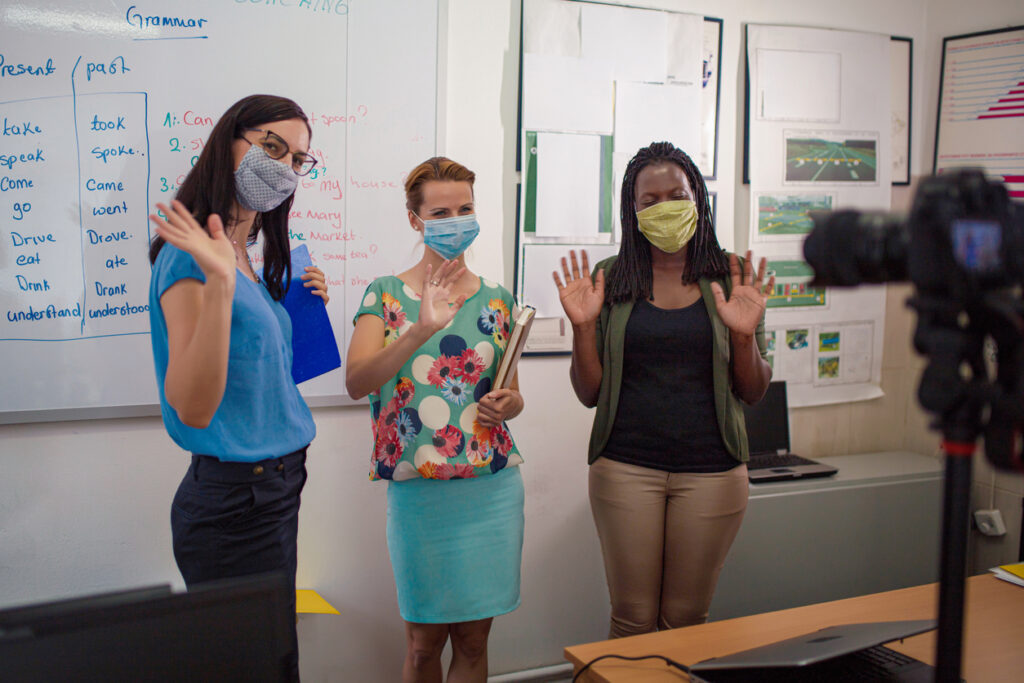
Cultivating active listening strategies throughout a school community and supporting parents to utilize these skills at home gives schools the extra boost needed to address school climate concerns. But how do schools get started with embedding this practice across their programs?
Build the listening foundation with school staff
Active listening skills take time, attention, and consistency from both schools and families to reap its benefits. Educators can initiate the first ‘ripple’ of active listening practices among school administrators, staff, and teachers to establish a strong foundation for this shift.
Advanced preparation is key to successfully introducing any change to school staff, especially ones intended to shift from a negative school climate to a positive one. Consider the most common hurdles to school climate improvement through active listening. It is critical to take time upfront to reflect on them and develop a plan for helping your teachers, administrators, and other staff to navigate them.
Navigating polarized climates
Teachers and staff are on the front lines doing everything they can to acknowledge and address parent feedback about how things are going in the classroom. But these days, viewpoints on education are increasingly polarized, and it feels especially difficult to have productive conversations with people who hold differing perspectives.

Active listening both de-escalates tense discussions and resets parties toward a shared goal of supporting student and school success. More importantly, by making others feel heard, staff build trust, and this is critical to developing caring relationships with families and other community members supporting school climate improvement.
Navigating change management
It is normal for teams to feel nervous during change, especially during tumultuous times. For some schools, active listening may represent a major shift in culture. Consider using one of these six models of change management in education to build a change management plan and team to drive it. It helps normalize staff’s feelings and provides them with tools for processing these changes. This strategy can be just the catalyst that a school needs to embrace new listening practices.
Navigating shared expertise
At its core, active listening means shifting from being an expert to being an open-minded learner. Educators are trained professionals – they have a right to expect respect for the time and effort they put into cultivating this expertise. It may feel uncomfortable for staff to be asked to invite a lay audience to problem-solve something like a school’s climate together.
Throughout this process, gently remind teaching staff, leaders, and yourself that their knowledge is valued – and that active listening complements that expertise, not diminishes it. You can also reinforce that it is okay not to give advice, directions, or insights in all discussions. When staff welcome families’ voices, in partnership with educator expertise, education leaders collaboratively discover strategies for improving school climate, in the classroom setting and beyond.
Navigating time and effort
Everyone’s schedules are packed. At first glance, active listening may appear to consume more time and effort than is available. However, upfront investment in developing these skills yields long-term benefits. Gains like improved communication skills, deeper trust, and active collaboration among staff ultimately save time, too — not to mention boost student academic achievement and teacher job satisfaction!
Try introducing simple listening practices during dedicated times like staff meetings first, then layering in communication norms elsewhere. Little by little, school leadership help staff integrate active listening into existing routines, without adding to everyone’s plates.
At first, these shifts may be challenging for leadership, administrators, staff, and teachers to adapt. Again, that’s okay! Honor that difficulty while creating a supportive community among your staff to navigate these changes.

Expand active listening to family-school partnerships
Once the foundations of active listening are in place among adults on campus, it’s time to expand these practices outward into family-school partnerships. Ongoing communication is key to developing collaborative relationships with families, in turn improving school climate. By integrating active listening into family communication strategies, school districts establish trust with vital stakeholders necessary for a positive school climate.
Audit your listening opportunities
Begin with reviewing your school’s existing communication methods with families, and examining how they may support active listening. Start with these guiding questions:
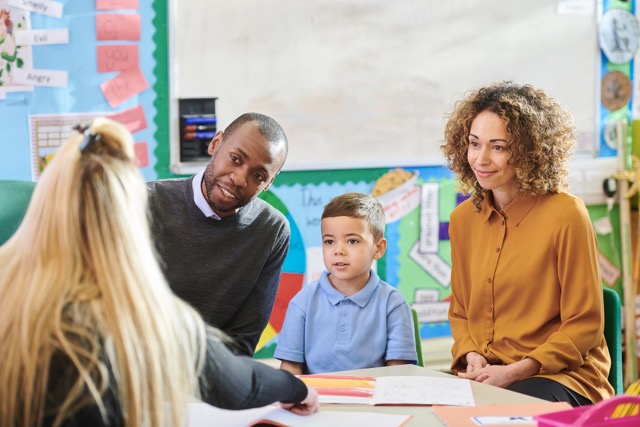
- How do teachers and other staff currently listen to families and students? For example, what does listening look like during parent-teacher conferences, policy councils, or school workshops?
- How often do we send school climate surveys to our families? Are there other ways we gather feedback beyond live meetings with families?
- Do parents, caretakers, and guardians know about these listening opportunities? How often are they participating in these opportunities for collaboration?
- Are we designing listening opportunities in a culturally responsive way? Are they accessible and welcoming to all families?
- Have I set the stage for each teacher to be able to listen? For example, do we have interpreters or other language resources necessary in these opportunities so we can hear from families?
As you review these questions, identify the most important changes needed in schools and develop solutions for those areas first. Start small when setting the stage for active listening among teachers, school staff, and families.
Close the feedback loop with parents
Receiving input is only one part of active listening. It is just as crucial to share back with families how their insights contribute to positive and safe environments at school.
When communicating about new programs or changes with families, clarify what information played a role and where it came from. Did parent feedback during Open House or Back-to-School Night contribute to creating a new after-school program? How did families feel about school safety in the latest school climate survey data, and what impact does this input have on social and emotional learning efforts at your schools? Make sure to highlight any additional resources or context when announcing plans for responding to family feedback.
Surveys are one of the best school climate resources available. They offer an easy way for schools to collect and share family insights. Check out our webinar to learn how surveys improve school-family communication and generate a positive climate on campus.

Develop easy routines for parents to communicate
Create regular routines for parents to build habits of sending information from home to the classroom to cultivate a school climate centered on open dialogue.
For example, try adding a notepad and pen to students’ ‘take-home’ folders, encouraging parents to share thoughts and comments back with teachers. Or ask them to share a meaningful artifact from home, a cherished book in their home language, or a favorite family recipe. All of these methods give families nonverbal ways to express who they are and what they value with their child’s teacher.
Whatever routines you establish, remember that the more consistent they are, the more comfortable parents will become with sharing back with schools. At the end of the day, you are using your school’s active listening practices to strengthen family relationships and build a positive school climate over time.
Take active listening beyond the classroom
Active listening among all adults at school supports both student achievement and a healthy school environment. As your school leaders, staff, and families become confident in these methods, shift focus to expanding active listening beyond the school context — bringing it home.
Schools can empower families to develop active listening skills with their students. Listening becomes especially important during adolescence. In these pivotal years, communication changes greatly between a parent and child. It may be challenging for families to collect crucial information about students that supports their learning at school.
Teaching tools that help parents actively listen to their teenagers helps them glean deeper insights about how their child feels about school, friends, etc. Families can then exchange this information with teachers, enabling staff to then understand and address students’ needs in the classroom — all of which benefits school climate.
ParentPowered developed a new listening guide for parents raising teenagers (or any aged student). Download the resource to share or read for your own learning!

Active listening helps the entire school community
Active listening is a critical skill that strengthens the most essential adult relationships around students. When active listening becomes part of the school climate improvement process, educators create a pathway to connection for the whole community to process the traumas of the pandemic. Strong family-school partnerships boost school climate and student achievement, and such supports are much needed to heal during this difficult season in education.
About the author
Maren Madalyn has worked at the intersection of K12 education and technology for over a decade, serving in roles ranging from counseling to customer success to product management. She blends this expertise with fluid writing and strategic problem-solving to help education organizations create thoughtful long-form content that empowers educators.

